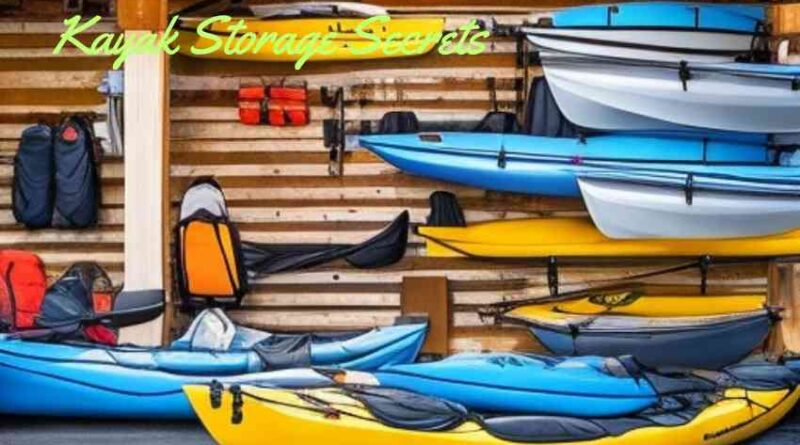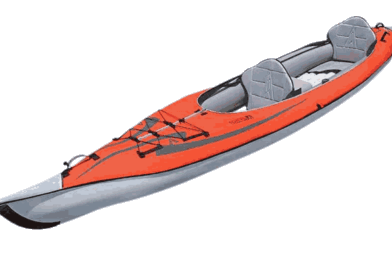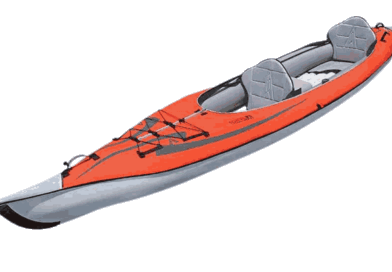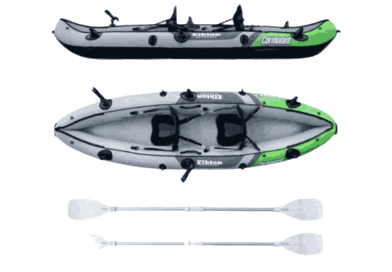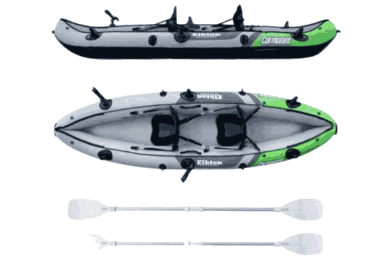Kayak Storage Secrets: Your Ultimate Guide!
Kayak Storage Secrets: From Summer Sun to Winter Snow - Your Ultimate Guide!
Are you a kayak enthusiast looking for the best storage solution for your beloved watercraft?
In this comprehensive guide, we’ve covered everything you need to know about storing your kayak, from whether it’s okay to leave it outside in the summer to how to store it in your garage.
As an expert angler, I guarantee that you’ll find all your burning questions answered here.
Should you store your kayak upside down or right side up? Can you store it on a roof rack? Why do kayaks have holes in the floor? We’ve got you covered.
So grab a cup of coffee, sit back, and enjoy reading this engaging and fun guide to storing your kayak. Your watercraft will thank you for it!
Table of Contents
Can you leave kayaks outside in summer?
You can keep your kayak outside in summer, but protect it from sun damage by storing it in a shaded area and covering it with a secure tarp or kayak cover. Animals can damage it, so take precautions to prevent them from making it their home.
Don’t forget to clean and dry your kayak before storing it to prevent mold and mildew.
Now, let’s talk about whether it’s safe to store your kayak outside during the winter months.
Is it OK to store kayak outside in winter?
Yes, you can store your kayak outside in winter, but it’s important to protect it from the sun and snow. UV rays from the sun can damage the material, so cover it with a tarp. Snow and falling tree branches can also be a problem, so keep it clear of these. Here are some tips to keep in mind:
- Cover your kayak with a tarp for UV protection
- Keep it clear of snow and falling tree branches
- Don’t leave it outside for extended periods of time
- Consider storing it indoors if possible
- Check for any damage before using it again in the spring
By following these tips, you can safely store your kayak outside during the winter months.
Now that we know it is possible to store kayaks outside in winter, the question remains: should kayaks be stored inside or outside?
Should kayaks be stored inside or outside?
Kayaks should ideally be stored indoors as it offers the best protection. However, if indoor storage is not practical, outdoor storage is suitable as long as the kayak is protected from the sun and weather. Here are some tips on how to store your kayak:
| Indoor Storage | Outdoor Storage |
|---|---|
| Keep the kayak in a dry and cool place | Cover the kayak with a tarp or UV-resistant cover |
| Hang it from the ceiling or place it on a rack | Place it under a shelter or in a shaded area |
| Make sure it is not in the way of foot traffic | Secure it to prevent theft or damage from wind |
Remember to clean and dry your kayak before storing it to prevent mold and mildew growth. Proper storage will help extend the life of your kayak and keep it in good condition for your next adventure!
Speaking of outdoor storage, another option for storing a kayak is using a roof rack on a car.
Can you store kayak on roof rack?
A roof rack system is a safe and reliable way to transport your kayak on top of your vehicle. It helps prevent damage to both your car and kayak. Before choosing a rack, make sure to consider your vehicle’s make and model, as well as the available mounting points.
Here are some key points to consider:
- Roof rack systems come in different styles, such as J-style, saddle-style, and stacker-style. Each has its own advantages and disadvantages based on your needs.
- Make sure to choose a rack that matches your kayak’s weight and length to avoid any problems on the road.
- Some roof racks may require additional accessories, such as straps or tie-downs, to secure your kayak in place.
- Always check the manufacturer’s instructions and follow them carefully to ensure proper installation and use.
Now that you know how to safely transport your kayak on a roof rack, you may be wondering whether it’s better to transport it right-side up or upside down.
Should I transport my kayak upside down?
If you’re traveling with your kayak and it looks like bad weather is coming, it’s best to position your kayak upside down if you can. This is because a kayak that’s filled with water can become dangerous. If you can’t position it upside down, use a portage cover to seal the cockpit.
Make sure to check your straps regularly to ensure they haven’t stretched while wet. Here are some key points to remember:
- Position your kayak upside down if possible when traveling in bad weather
- Use a portage cover to seal the cockpit if upside down isn’t possible
- Check your straps regularly to make sure they haven’t stretched while wet
- A kayak heavy with water can be dangerous, so be careful.
Now let’s discuss another important aspect of transporting kayaks – the angle of kayak racks.
Why are kayak racks angled?
Kayak racks are angled to help reduce wind resistance while driving, which can improve fuel efficiency and prevent damage to the kayak. Additionally, the angle helps to provide more clearance for the kayaker’s arms when loading and unloading the kayak.
Now that we understand why kayak racks are angled, let’s explore how to store a kayak in your garage.
How do you store a kayak in your garage?
Storing a kayak in your garage can be a challenge, but there are several options to consider. You can use a wall-mounted rack, overhead suspension system, upright storage, wall-mounted sling set or portable stands
| Method | Description |
|---|---|
| Wall-mounted rack | If you have plenty of wall space, this is a great storage solution that won’t take up any floor space. It’s perfect for multiple kayaks. |
| Overhead suspension system | This system uses pulleys and ropes to lift and store your kayak overhead. It’s a great option if you have high ceilings. |
| Upright storage | This is a simple and effective way to store your kayak vertically. It’s ideal if you have limited space in your garage. |
| Wall-mounted sling set | This system uses straps to suspend your kayak from the wall. It’s easy to install and can be used for other outdoor gear too. |
| Portable stands | These stands are a good choice if you need to move your kayak around your garage or take it with you on trips. They’re lightweight and easy to store. |
These storage solutions can help you save floor space and keep your kayak safe and organized. Just make sure you have enough wall space and choose the option that works best for your needs.
Now that we have explored different options for storing a kayak in your garage, let’s discuss how a kayak should be stored.
How should a kayak be stored?
Kayak storage is important for keeping your kayak in good condition and extending its lifespan. You can prevent damage and warping by using a designated rack and protecting it from sunlight.
To store your kayak properly, follow these steps:
- Use a designated kayak rack to keep it off the ground.
- Protect it from direct sunlight to prevent damage to the exterior and warping.
- Lock it up to a secure structure like a garage or shed to prevent theft.
Now that you know how to store your kayak properly, you may be wondering about the best orientation for storage.
Should I store my kayak upside down or right side up?
It’s best to store your kayak upside down to avoid damaging the hull. This helps prevent dents scratching, sagging, and deformities in the hull. Make sure to distribute the weight evenly on your mounting system and space the kayak evenly. Here’s a quick guide:
- Store kayak upside down
- Avoid denting or deforming hull
- Minimize the potential for scratching and sagging
- Distribute weight evenly
- Space kayak evenly
- Follow these tips for safe and effective kayak storage
To keep your kayak in top condition, here’s what you need to know about storing it when not in use.
How do you store a kayak when not in use?
The best way to store your kayak outdoors when not in use is to keep it away from water and under a cover. You can use mounting racks to keep your kayaks off the ground and to make them easily accessible. Another option is to store them under a deck.
Here are some tips for storing your kayak outdoors:
- Use a cover to protect your kayak from the elements
- Store your kayak on its side to prevent warping
- Keep your kayak away from direct sunlight to prevent fading and damage
- Use a lock or security system to prevent theft
- Inspect your kayak regularly for any signs of damage or wear and tear
Remember to clean and dry your kayak before storing it to prevent mold and mildew buildup. With these tips, you can safely store your kayak outdoors and keep it in good condition for many years to come.
Speaking of kayak storage, you may be wondering whether it’s safe to store your kayak vertically.
Is it okay to store kayaks vertically?
Storing your kayak vertically by leaning it against a wall or laying it flat is not recommended. This puts too much weight on the nose or tail, which can damage the kayak over time. Instead, it’s best to distribute the weight evenly by using a kayak rack or hoist system.
This will help prolong the life of your kayak and keep it in good condition for longer. Remember to always follow the manufacturer’s recommended storage guidelines for your specific kayak model.
Now, if you’re wondering how to properly store your fishing kayak, there are a few things to keep in mind.
How do you store a fishing kayak?
To store a fishing kayak, you should follow these steps:
- Clean and dry your kayak before storing it.
- Find a dry and cool place to store your kayak.
- Store your kayak on its side or upside down to prevent warping.
- Use a kayak cover to protect it from dust, sunlight, and moisture.
- If possible, store it off the ground on a rack or hooks.
Storing your kayak properly will help keep it in good condition and ready for your next fishing trip!
Now that we’ve covered how to properly store a fishing kayak, you may be wondering: should kayaks have water in them?
Should kayaks have water in them?
It’s normal for water to be inside a sit-on-top kayak. However, if your feet are in a lot of water, something might be wrong with the kayak.
Here are some possible reasons for excess water in your kayak:
- Poorly sealed hatches or scupper holes
- Cracks or holes in the hull or cockpit rim
- Improperly installed accessories or modifications
- Rough water or waves splashing over the kayak
If you’re experiencing excessive water inside your kayak, it’s best to inspect it for any visible damage or leaks. Regular maintenance and proper storage can also help prevent water from accumulating in your kayak.
Now that we’ve discussed some common issues that can cause water to accumulate in a kayak, let’s explore another important aspect of kayak durability: how long plastic kayaks typically last.
How long do plastic kayaks last?
According to experts, plastic kayaks can last anywhere from 10 to 25 years with proper care and maintenance. Factors such as exposure to sunlight, temperature changes, and rough handling can affect the lifespan of a kayak.
Regular cleaning, storage in a dry place, and avoiding dragging the kayak on rough surfaces can help extend its lifespan. It is also important to inspect the kayak for any cracks or damage before and after each use.
Speaking of kayak maintenance, a common question that arises is whether it is necessary to winterize a kayak.
Do you need to winterize a kayak?
Winterizing a kayak or raft means taking steps to protect it from the harmful effects of freezing temperatures and moisture buildup. By doing so, you can prolong the life of your watercraft and ensure it stays in good condition for years to come.
Here’s why you should winterize your kayak:
- Freezing temperatures can weaken the materials and cause them to crack or become brittle.
- Moisture buildup can lead to warped seals and other damage.
- Winterizing helps prevent these issues and keeps your kayak or raft in top shape.
Some tips for winterizing your kayak include:
- Cleaning and drying it thoroughly before storing.
- Removing any accessories or attachments that could be damaged by freezing temperatures.
- Storing it in a dry, cool place, away from direct sunlight.
- Covering it with a tarp or other protective cover.
By taking these simple steps, you can protect your kayak from winter damage and ensure it’s ready to go when spring comes around.
Let’s address a common question: why do kayaks have holes in the floor?
Why do kayaks have holes in the floor?
Scupper holes are holes intentionally designed in sit-on-top kayaks, like fishing kayaks. They serve two purposes – first, to give the kayak structural strength, and second, to act as a drain hole when water gets in. These holes allow water to flow out of the boat, keeping it from becoming too heavy and unstable.
So, don’t worry if you see holes in your kayak- they’re supposed to be there!
Frequently Asked Questions
What is the best way to store a kayak during the winter months?
The best way to store a kayak during the winter months is to keep it in a dry, cool place such as a garage or storage shed.
Can leaving a kayak outside in the summer heat damage the material or structure of the kayak?
Leaving a kayak outside in the summer heat can damage the material and structure of the kayak over time.
What are the benefits of storing a kayak inside versus outside?
Storing a kayak inside offers protection from weather and potential theft, while storing outside may be more convenient and save space.
How do you properly transport a kayak on a roof rack without causing damage?
Properly transport a kayak on a roof rack by securing it with straps and padding to prevent scratches or damage.
Is it necessary to store a kayak upside down or right side up and what is the reasoning behind it?
Storing a kayak upside down is recommended to prevent warping and distortion of the hull due to gravity and pressure.
What Can you do now?
Now that you know how to properly store and transport your kayak, it’s time to get out on the water! If you’re in the market for a new kayak, check out our review of the most demanded kayaks on the market. With the right kayak and proper storage and transportation techniques, you can enjoy many years of paddling adventures.
Now that we have covered the basics of kayaking and how to store your kayak, let’s switch gears and delve into the physical and safety aspects of this popular outdoor activity. If you’re curious about the health benefits of kayaking, the most common injuries, or even the most popular stroke, head on over to our next article. It’s time to explore the exciting world of kayaking from a different perspective.
